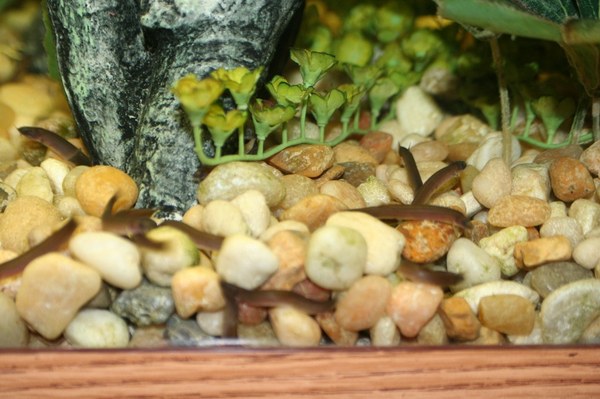Breeding experience with Pangio oblonga.
I discovered news of this on another website in early April 2007 and these are Richard's words from there.......
"It was late at night and I was sitting on the floor real close to my 55 gal.
fish tank, looking at my fish, as I was talking with my wife Annemarie last week
some time. My eye level was at the bottom of the tank and as I was watching my
Pleco I saw something moving in my rocks! I looked closer and said to Annemarie,
"I think I have worms in the tank." She said, "How, you haven't added anything
in at all in a few months." I said, "Yeah, you are right" and looked closer. I
said, "They aren't worms, they are loaches!" She looked with me and confirmed
that they were about a half inch long, grey tan body and gills, eyes and a small
tail. My Java Loaches had babies! (Are they called fry when they are hatched
from eggs?) I looked on the internet and saw that breeding for these fish ranged
from "unknown" to "difficult" to "not done in tanks"... They are very cool
looking. I have 1/2" - 1" size natural stones on the bottom and they swim in and
around them... The only way to see them is looking up from the bottom of the
tank with a flash light. They are always moving around finding food. The best I
can tell is there are about 15-20 of them."
- Richard and Annemarie's tank is a 55 (US) gallon.
- Temperature is normally 78F to 80F
- pH 7.8 to 8.0
- kH normally around 20+
- gH is 18-22
These parameters are not normally regarded as ideal for kuhlis and this had been of some concern to Richard. A common member to both site's forums had advised him to not worry too much about this and instead concentrate on giving the fish stable and clean conditions. this was obviously sound advice as unhappy fish do not normally breed. This fits with my personal credo on aquarium keeping as I regard good clean water and good feeding to be of greater importance in the long run than totally replicating natural hardness and pH levels.
The Loaches Online recommendations for this species are:
Water parameters: pH: 6.4-7.0 Hardness: Soft
LOL recommends wholeheartedly that all Pangio species be kept on a sand substrate. This is because they enjoy burrowing and it is kind to their delicate barbels. In this area Richard's tank is a complete departure as it features what he refers to as "rocks". Certainly in kuhli scale terms these are rather huge boulders but in this case it seems that they may have been of huge advantage. The eggs and tiny fry were protected from predation by other tank inhabitants by the substrate itself. They could hide safely within until they reached a size where the other tank inhabitants would not regard them as a tasy, wormy snack. Also, the large size of the grains compared to a kuhli mean there are no sharp edges to damage the fish like some smaller gravels might have presented. Certainly, we would recommend sand for kuhlis in long-term care, but Richard's setup with large gravel is very well worth considering if one was trying to replicate his success with this or another Pangio species. This is similar to procedures used by breeders of Danio species who fill the bottom of a tank with glass marbles to allow eggs to fall between and not be eaten by the egg-predating spawners.
These are the first picture that Richard posted on April 17th 2007, taken from under the aquarium.


On June 14th 2007, Richard posted these pictures. The fish were now regularly foraging on the substrate surface and big enough not to be eaten by other tank mates.
 |
 |
| Below is their Mom |
 |
| Picture taken from underneath the aquarium |
 |
 |
 |

On the 22nd August 2007 Richard added these pictures. The babies have now grown substantially and he describes how feeding time is just a writhing mass of hungry fishies.
 |
 |
| Here are some of them with Mom who appears to be filling up with eggs again. |
 |
 |
 |
| A great picture to end on showing what a cute, wiggly bunch they are. |
 |

Congratulations on your success and many thanks to Richard for sharing these images with us and good luck with any future spawnings.
This is a prime example of how healthy fish are happy fish and how they want to procreate. Good, stable aquarium conditions are the best thing. Obviously, these fish were not put off by water conditions that were somewhat removed from what they might experience in nature. Unlike some species where these parameters are highly necessary for hatching of eggs to take place, it seems that P. oblonga are not so sensitive and this may hopefully be the case with other Pangio species too.
Text by: Martin Thoene
Photographs: Richard Bias
Document Actions

